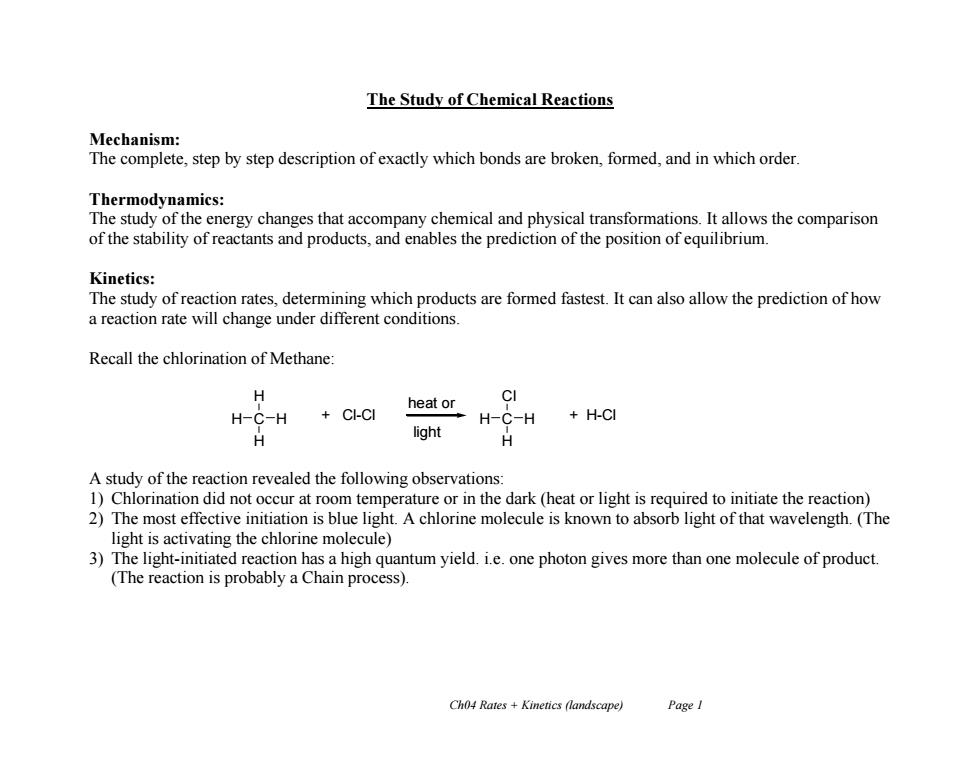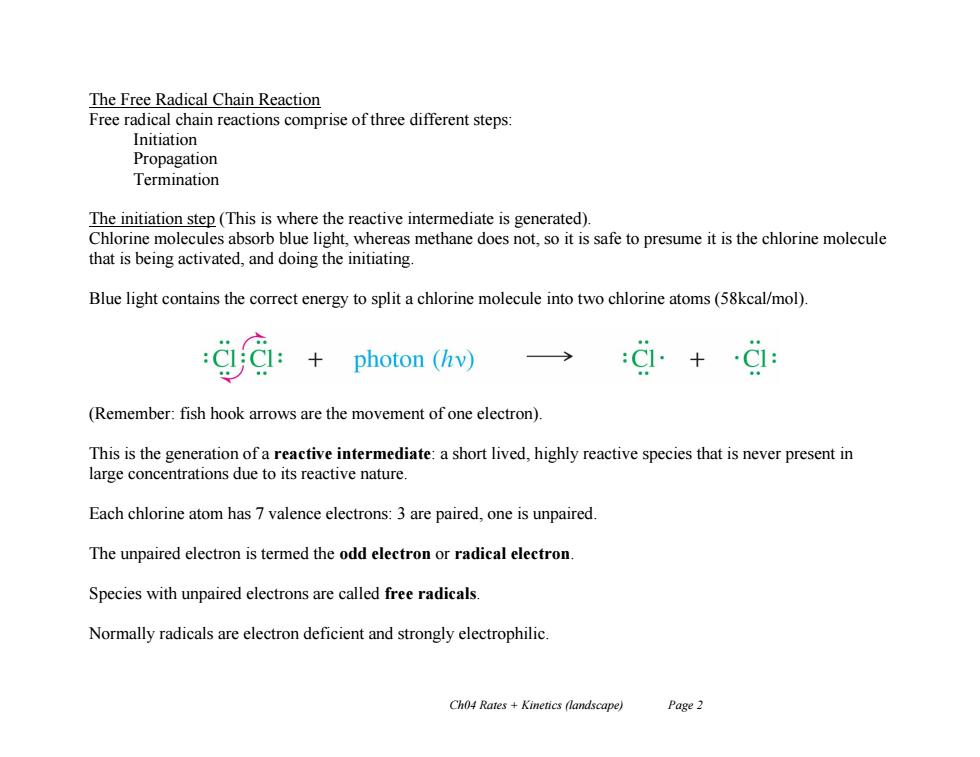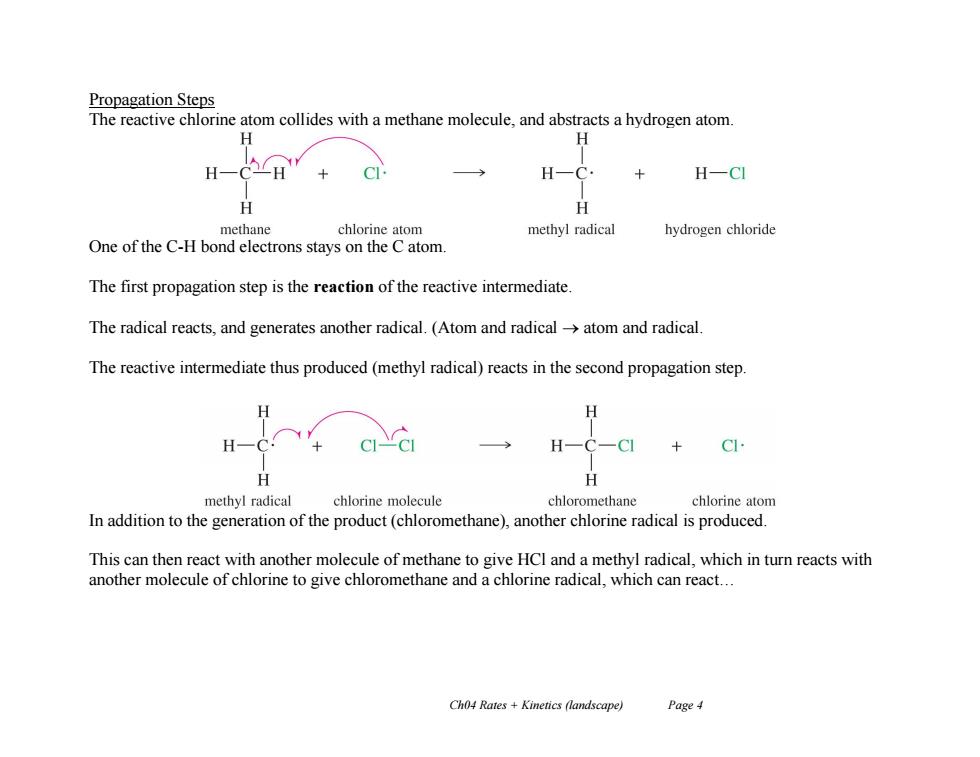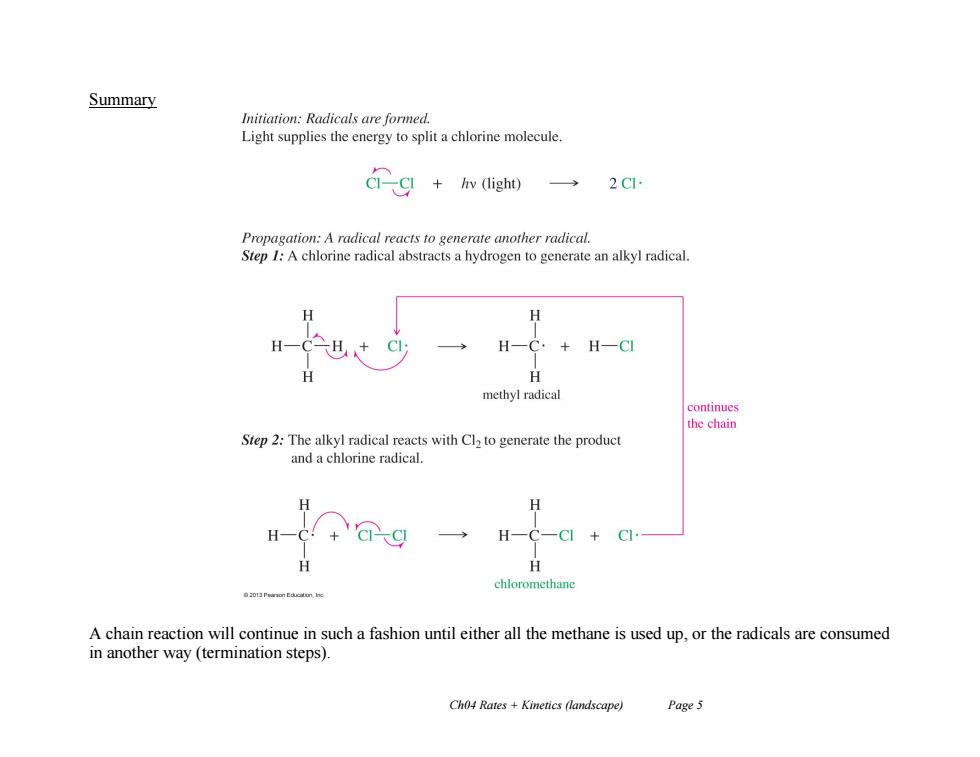
The Study of Chemical Reactions Mechanism: The complete,step by step description of exactly which bonds are broken,formed,and in which order. Thermodynamics: The study of the energy changes that accompany chemical and physical transformations.It allows the comparison of the stability of reactants and products,and enables the prediction of the position of equilibrium. Kinetics: The study of reaction rates,determining which products are formed fastest.It can also allow the prediction of how a reaction rate will change under different conditions. Recall the chlorination of Methane: CI heat or H-C-H CI-CI H-C-H +H-CI light H A study of the reaction revealed the following observations: 1)Chlorination did not occur at room temperature or in the dark (heat or light is required to initiate the reaction) 2)The most effective initiation is blue light.A chlorine molecule is known to absorb light of that wavelength.(The light is activating the chlorine molecule) 3)The light-initiated reaction has a high quantum yield.i.e.one photon gives more than one molecule of product. (The reaction is probably a Chain process). Ch04 Rates +Kinetics (landscape) PageI
Ch04 Rates + Kinetics (landscape) Page 1 The Study of Chemical Reactions Mechanism: The complete, step by step description of exactly which bonds are broken, formed, and in which order. Thermodynamics: The study of the energy changes that accompany chemical and physical transformations. It allows the comparison of the stability of reactants and products, and enables the prediction of the position of equilibrium. Kinetics: The study of reaction rates, determining which products are formed fastest. It can also allow the prediction of how a reaction rate will change under different conditions. Recall the chlorination of Methane: A study of the reaction revealed the following observations: 1) Chlorination did not occur at room temperature or in the dark (heat or light is required to initiate the reaction) 2) The most effective initiation is blue light. A chlorine molecule is known to absorb light of that wavelength. (The light is activating the chlorine molecule) 3) The light-initiated reaction has a high quantum yield. i.e. one photon gives more than one molecule of product. (The reaction is probably a Chain process). H H C H H + Cl-Cl Cl H C H H + H-Cl heat or light

The Free Radical Chain Reaction Free radical chain reactions comprise of three different steps: Initiation Propagation Termination The initiation step (This is where the reactive intermediate is generated). Chlorine molecules absorb blue light,whereas methane does not,so it is safe to presume it is the chlorine molecule that is being activated,and doing the initiating. Blue light contains the correct energy to split a chlorine molecule into two chlorine atoms(58kcal/mol). photon (hv) → (Remember:fish hook arrows are the movement of one electron) This is the generation of a reactive intermediate:a short lived,highly reactive species that is never present in large concentrations due to its reactive nature. Each chlorine atom has 7 valence electrons:3 are paired,one is unpaired. The unpaired electron is termed the odd electron or radical electron Species with unpaired electrons are called free radicals. Normally radicals are electron deficient and strongly electrophilic. Ch04 Rates Kinetics (landscape) Page 2
Ch04 Rates + Kinetics (landscape) Page 2 The Free Radical Chain Reaction Free radical chain reactions comprise of three different steps: Initiation Propagation Termination The initiation step (This is where the reactive intermediate is generated). Chlorine molecules absorb blue light, whereas methane does not, so it is safe to presume it is the chlorine molecule that is being activated, and doing the initiating. Blue light contains the correct energy to split a chlorine molecule into two chlorine atoms (58kcal/mol). (Remember: fish hook arrows are the movement of one electron). This is the generation of a reactive intermediate: a short lived, highly reactive species that is never present in large concentrations due to its reactive nature. Each chlorine atom has 7 valence electrons: 3 are paired, one is unpaired. The unpaired electron is termed the odd electron or radical electron. Species with unpaired electrons are called free radicals. Normally radicals are electron deficient and strongly electrophilic

Common Radicals in Organic Chemistry Lewis structures H HH :过 r H:O. H:C. H:C:C. H 丑H Written C Br HO CH3 CHCH2 chlorine atom bromine atom hydroxyl radical methyl radical ethyl radical Ch04 Rates +Kinetics (landscape) Page 3
Ch04 Rates + Kinetics (landscape) Page 3 Common Radicals in Organic Chemistry

Propagation Steps The reactive chlorine atom collides with a methane molecule,and abstracts a hydrogen atom H H H-CH C H一 H-CI H H methane chlorine atom methyl radical hydrogen chloride One of the C-H bond electrons stays on the C atom. The first propagation step is the reaction of the reactive intermediate. The radical reacts,and generates another radical.(Atom and radical->atom and radical The reactive intermediate thus produced(methyl radical)reacts in the second propagation step. H C H methyl radical chlorine molecule chloromethane chlorine atom In addition to the generation of the product(chloromethane),another chlorine radical is produced. This can then react with another molecule of methane to give HCl and a methyl radical,which in turn reacts with another molecule of chlorine to give chloromethane and a chlorine radical,which can react... Ch04 Rates +Kinetics (landscape) Page 4
Ch04 Rates + Kinetics (landscape) Page 4 Propagation Steps The reactive chlorine atom collides with a methane molecule, and abstracts a hydrogen atom. One of the C-H bond electrons stays on the C atom. The first propagation step is the reaction of the reactive intermediate. The radical reacts, and generates another radical. (Atom and radical atom and radical. The reactive intermediate thus produced (methyl radical) reacts in the second propagation step. In addition to the generation of the product (chloromethane), another chlorine radical is produced. This can then react with another molecule of methane to give HCl and a methyl radical, which in turn reacts with another molecule of chlorine to give chloromethane and a chlorine radical, which can react…

Summary Initiation:Radicals are formed. Light supplies the energy to split a chlorine molecule. Gg+wigh一 Propagation:A radical reacts to generate another radical. Step I:A chlorine radical abstracts a hydrogen to generate an alkyl radical. H-C. +HCI H methyl radical continues the chain Step 2:The alkyl radical reacts with Cl2 to generate the product and a chlorine radical. H H H chloromethane 20Pearmn Eaucatunt he A chain reaction will continue in such a fashion until either all the methane is used up,or the radicals are consumed in another way (termination steps). Ch04 Rates +Kinetics (landscape) Page 5
Ch04 Rates + Kinetics (landscape) Page 5 Summary A chain reaction will continue in such a fashion until either all the methane is used up, or the radicals are consumed in another way (termination steps)